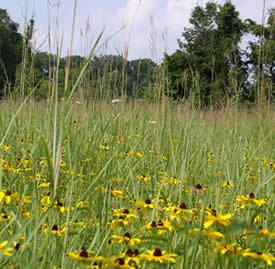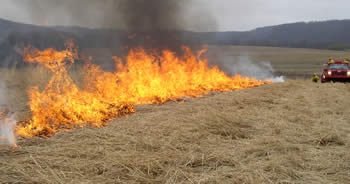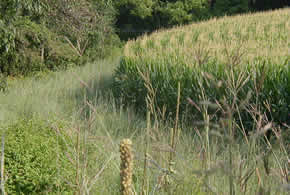|
Helping People Help the Land and Its Wildlife
By Timothy Dunne
NRCS Resource Conservationist
January, 2006 (updated September, 2006)
|
Early
successional habitats, particularly grasslands, were once quite common throughout
New Jersey. Our coastal areas have had large expanses of natural grassland for
thousands of years, mostly covered by Spartina, also known as salt hay or cordgrass.
Agricultural grasslands, dominated by European grasses such as ryegrass, orchardgrass,
fescue, timothy and others, have been abundant here since European settlement.
In
the early 20th Century the agricultural landscape began to change. Increased human
populations and loss of farmland to natural succession and development contributed
to declines in the quantity and quality of New Jersey's grasslands. Today only
about 5% of New Jersey's landscape remains in early successional stages. Grassland
bird populations that once thrived in our farmland landscapes are now declining.
Species such as the Northern bobwhite, Eastern meadowlark, bobolink, ring-necked
pheasant and many others are becoming uncommon and face challenges to survive.
|
 Native
grass/wildflower meadow established three years earlier at a Partners for Fish
and Wildlife site on a Mercer County farm.
Native
grass/wildflower meadow established three years earlier at a Partners for Fish
and Wildlife site on a Mercer County farm. |
But
there is good news! The New Jersey DEP's Division of Fish and Wildlife (DFW) has
partnered with the United States Department of Agriculture's Natural
Resources Conservation Service (NRCS), the United States Department of the
Interior's Fish
and Wildlife Service (USFWS) and non-governmental organizations, including
NJ Audubon,
to implement a proactive plan of action to conserve and restore wildlife habitat.
A key component of the plan includes placing a DFW wildlife biologist at all six
of the NRCS field offices throughout the state. Two positions have already been
filled and more will be added as funding becomes available.

Winter
prescribed burning of this native grass field in Warren County will invigorate
native grasses and control unwanted weedy plants. Project is funded by USDA through
a WHIP agreement with the local landowner. |
These
new biologists will help interested landowners obtain assistance for conservation
programs on their land. Both technical and financial assistance (cost-sharing)
is available to landowners enrolled in the conservation programs. Cost-sharing
means that the landowner provides a portion of program cost, either monetary or
through in-kind services (i.e., labor and equipment provide by and used by the
landowner to implement conservation practices are considered in-kind services).
|
A
variety of state and federal programs are available. The US
Department of Agriculture's Farm Bill includes several different programs
that target different natural resources in need of protection and were designed
to create and protect wildlife habitat at little or minimal cost to the landowner.
In addition to restoring and establishing fish and wildlife habitat, the Farm
Bill's conservation provisions help reduce soil erosion, safeguard streams and
rivers, protect valuable groundwater resources and improve air quality - things
we all benefit from. Reducing the financial risk associated with drought or flooding
is an additional benefit to farmers enrolling portions of properties in the appropriate
conservation program.
USDA Farm Bill Programs
Wildlife
Habitat Incentive Program (WHIP)
Through
the Wildlife Habitat Incentives Program (WHIP), USDA Natural Resources
Conservation Service (NRCS) provides both technical assistance and cost-share
assistance to establish and improve fish and wildlife habitat on non-federal land.
WHIP is a voluntary program. Landowners work with NRCS to prepare and implement
a wildlife habitat development plan. NRCS can provide up to 75% of the costs of
the planned practices to implement habitat improvements. There is no financial
limit on WHIP contracts. NRCS has provided up to $30,000 for an individual contract
in New Jersey, although most average around $5000.
See www.nj.nrcs.usda.gov/programs/whip/
for application information.
Wetland
Reserve Program (WRP)
The
Wetlands Reserve Program (WRP) is a voluntary program that provides technical
and financial assistance to eligible landowners to address wetland, wildlife habitat,
soil, water, and related natural resource concerns on private lands in an environmentally
beneficial and cost-effective manner. The program provides an opportunity for
landowners to receive financial incentives to enhance wetlands in exchange for
retiring marginal land from agriculture.
WRP participants benefit by:
- Receiving
financial and technical assistance in return for restoring and protecting wetland
functions and values
- Seeing
a reduction in problems associated with farming potentially difficult areas
- Having
incentives to develop wildlife recreational opportunities on their land.
See www.nj.nrcs.usda.gov/programs/wrp/
for application information.
Conservation
Reserve Enhancement Program (CREP)
|
Under
CREP, landowners voluntarily remove cropland along streams, lakes and wetlands
from agricultural production and convert the land to native grasses, trees and
other vegetation to provide buffers. These conservation buffers slow and absorb
runoff, sediment, nutrients, and chemicals from cropland while also creating beneficial
wildlife habitat for many species in need. CREP also pays landowners the cost
to establish eligible conservation practices, annual rental payments to maintain
the practices, and, in most cases, incentive payments to sign up for the program.To
view a fact sheet about CREP, from the USDA Farm Service Agency web site, go to:
www.fsa.usda.gov/pas/publications/facts/html/crepnj04.htm.
Additional
information about the many Farm Bill programs can be found at the NJ NRCS website:
www.nj.nrcs.usda.gov/programs.
|
 Native
grass buffers, established under the CREP program, provide wildlife habitat and
filter agricultural runoff, protecting the stream below.
Native
grass buffers, established under the CREP program, provide wildlife habitat and
filter agricultural runoff, protecting the stream below. |
Other Programs
Partners
for Fish and Wildlife is a US Fish and Wildlife Service program which, focuses
on restoring wetlands, grasslands, and riparian (streamside) areas. Over 150 projects
have been completed in NJ since 1991, restoring thousands of acres of wetlands
and seeding hundreds of acres to native grasses. Additional information can be
found at the Partners for Fish and Wildlife website: www.fws.gov/northeast/partners/.
|

Newly
emerged native grasses in this Somerset County farm field will grow vigorously
and create valuable grassland bird habitat in a few years. Project is funded through
a NJ DFW LIP agreement.
|
The
Landowner Incentive Program (LIP) is a NJ Division of Fish and Wildlife
program and is a relative newcomer to the wildlife habitat conservation scene.
LIP is funded through the US Fish and Wildlife Service with the intent of protecting
declining animal populations and their habitat. New Jersey LIP focuses on early
successional habitat, the lower 10 kilometers of Cape May Peninsula, and land
adjacent to permanently protected areas.
The
Division of Fish and Wildlife implemented LIP in 2004 and since then has accepted
projects protecting over 1,500 acres of grassland habitat, and will restore over
500 acres of that to native warm season grass meadows. Landowners typically engage
in a delayed mowing program on their land allowing ground nesting grassland birds
to fledge their young.
|
These
grassland projects protect over 15 declining wildlife species. In Hunterdon County
alone 10 landowners will manage grasslands under LIP. These five-year agreements
call for delayed mowing on nearly 800 acres and 200 acres will be seeded to native
warm season grasses. For more information on LIP go to the NJ Division of Fish
and Wildlife web site at: www.njfishandwildlife.com/ensp/lip_prog.htm.
To
find out more information on how you can establish, manage or enhance grassland
wildlife habitat in New Jersey, contact one of the two new private lands biologists.
For Northern New Jersey contact MacKenzie Hall at the NRCS office at 908-782-4614 x104. She is eagerly awaiting your call to help you help your land and its wildlife!
RELATED BOOKLETS
Conservation Profiles: Landowners Help Imperiled Wildlife (pdf, 1.3mb)
Working Together - Tools for Helping Imperiled Wildlife on Private Lands (pdf, 1.1mb)
|




